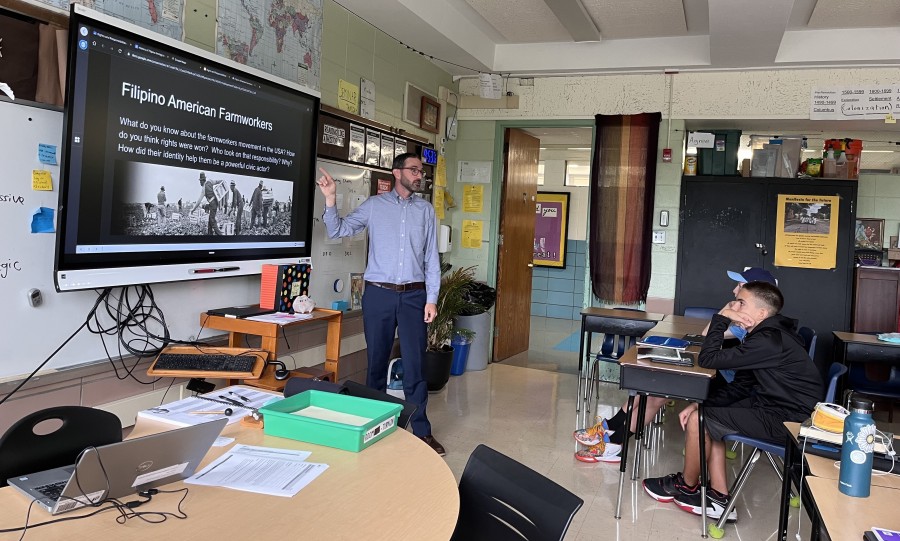 A new state law requires teaching Asian American history. Some teachers have jumped in headfirst, while others are still preparing lessons.
A new state law requires teaching Asian American history. Some teachers have jumped in headfirst, while others are still preparing lessons.
By Susie An (WBEZ)
In a dimly lit room on Chicago’s North Side, teacher Zach Schroeder is introducing his eighth graders to an historical figure most students — and teachers — have never encountered before.
They’re learning about labor movements, and Schroeder wants to extend his students’ knowledge beyond the important work of Cesar Chavez and the National Farm Workers Association.
He cues up a video focused on Filipino workers in the 1960s and Filipino American labor organizer Larry Itliong, telling his students to be mindful of how Itliong’s “identity helped him be a powerful civic actor.”
Students then break into groups and talk about why the efforts of Filipino American farm workers aren’t as widely known, and the importance of merging their efforts with Mexican farm workers. This was all new for Aisling Panjwani, one of Schroeder’s students.
“I think it highlights a lot of stories that maybe weren’t as prominent that maybe need to be highlighted more,” the eighth grader says.
That’s a key goal of the TEAACH Act, or Teaching Equitable Asian American Community History, which requires Illinois schools for the first time this year to teach a unit of Asian American and Pacific Islander history. It’s meant to boost cross-cultural education for all students and advance racial equity. Some teachers have jumped in headfirst, while others are still preparing their lessons. The law says every public elementary and high school should include a unit of AAPI history, but local schools have the freedom to decide what that looks like.

In his social studies and civics classroom, Schroeder is weaving Asian American history throughout the year, rather than only one unit.
“This lesson today, it talks about the labor struggle and how integral not just Asian Americans, but Latinx people, Mexican American people were together,” Shroeder said. “So I think it’s just natural to smooth it out throughout U.S. history.”
Schroeder said the more lenses you can add to history, the richer it becomes.
That’s true for educators as well. Smita Garg is a parent at Skinner North and helped lead teacher trainings with Asian Americans Advancing Justice, the group that helped get the TEAACH Act passed. Garg is Asian American and has a background in education, but this was a learning experience for her as well.
“I did not know this content,” she said. “So what I try to convey to teachers upfront in the sessions is, ‘It’s okay not to know. Let’s start there. Let’s give ourselves grace for what we don’t know, but also hold ourselves accountable for learning here on out.’ ”
Garg said she’s done trainings for entire school districts and has even had teachers from outside the state sign up. There are more workshops scheduled this fall, and there’s also free online resources that teachers can incorporate into their lessons for any grade level.





